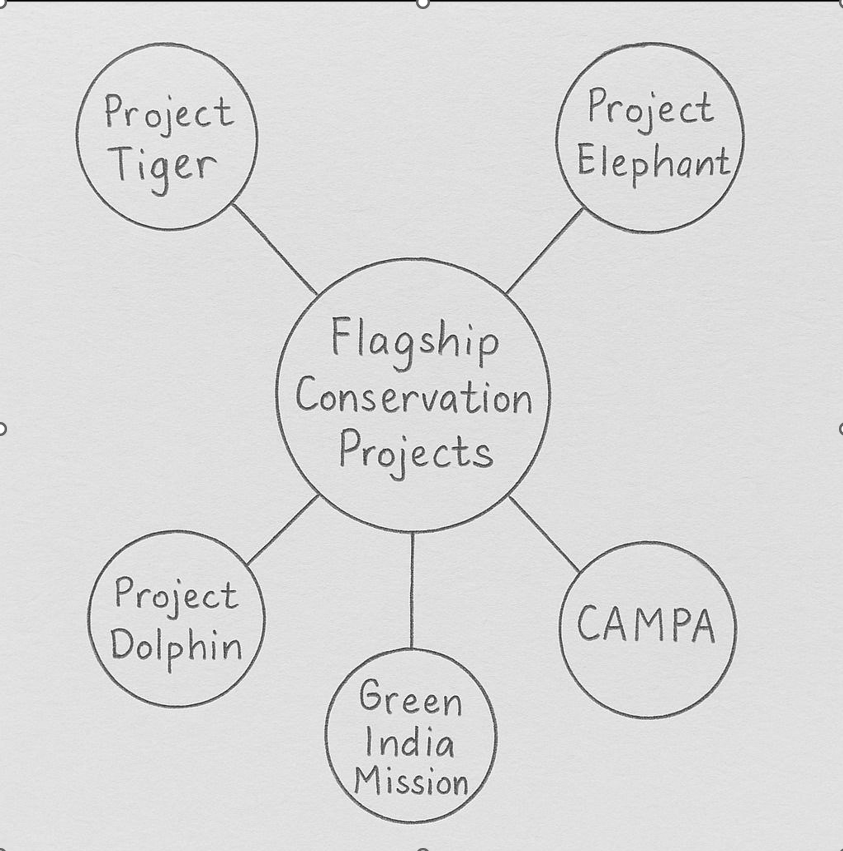There are no items in your cart
Add More
Add More
| Item Details | Price | ||
|---|---|---|---|
Wed Apr 30, 2025
Approach:
Introduction:
• Begin with a macro-level framing: India as a top 10 mega-diverse country globally.
• Mention biogeographic zones, ecological variation, and monsoon-driven biodiversity.
• Link biodiversity conservation to legal safeguards and SDG-15 (Life on Land).
Body:
A. Reasons for Rich Biodiversity
• Highlight India’s 10 biogeographic zones and their endemism (e.g., Western Ghats).
• Stress climatic and altitudinal diversity from Kerala to Ladakh.
• Mention wetlands and coastal hotspots like Sundarbans, Chilika.
• Refer to sacred groves and indigenous conservation practices.
• Showcase agrobiodiversity via traditional breeds and native crops.
B. Primary Threats to Biodiversity
• Explain habitat fragmentation through development projects (e.g., NH-7 in Pench).
• Detail poaching and illegal trade of tigers, pangolins.
• Mention invasive alien species like Lantana and African catfish.
• Show effects of pollution and over-exploitation (mining, pesticide runoff).
• Cite climate change stress (glacier retreat, coral bleaching).
C. State-Led Conservation Efforts
• List legislative acts: WPA 1972, FCA 1980, BDA 2002.
• Quote data on protected areas (NPs, WLS, BRs).
• Refer to flagship programs: Project Tiger, Elephant, CAMPA.
• Mention community models: JFM, BMCs.
• Include tech tools: GIS, camera traps, e-DNA.
Conclusion:
• Reinforce the ecological and livelihood value of biodiversity.
• Call for landscape-based planning, community stewardship, and tech-enabled governance.
• Emphasize integration of conservation
Introduction:
India ranks among the world’s top 10 mega-diverse countries, home to over 8% of global biodiversity. Its rich flora and fauna are shaped by 10 distinct biogeographic zones, diverse topography, and seasonal monsoon patterns. From the mangroves of the Sundarbans to the alpine meadows of the Himalayas, India hosts a vast range of ecosystems. However, growing anthropogenic pressures necessitate urgent conservation efforts through legal frameworks such as the Wildlife Protection Act, 1972, the Biological Diversity Act, 2002, and alignment with Sustainable Development Goal 15 (Life on Land).
Body:
A. REASONS FOR RICH BIODIVERSITY
1. Biogeographic Diversity
-India’s 10 zones (e.g., Himalayas, Western Ghats) harbour endemic species like Lion-tailed macaque, Hangul.
2. Climatic and Altitudinal Variation
-Zones from tropical Kerala to alpine Ladakh support 16 forest types (Champion & Seth).
3. Wetland and Coastal Ecosystems
-Sundarbans, Chilika, and Gulf of Mannar host species like dugongs, Olive Ridley turtles.
4. Traditional Knowledge and Sacred Groves
-Practices in Meghalaya and Tamil Nadu conserve local plants and animals.
5. Agrobiodiversity and Indigenous Breeds
-Varieties like Navara rice, Punganur cattle, and Banni buffalo enhance ecological richness.
B. PRIMARY THREATS TO NATURAL RESOURCES
1. Habitat Fragmentation
-Caused by highways, urbanisation (e.g., NH-7 slicing Pench tiger corridor).
2. Poaching and Illegal Trade
-Target species include pangolins, tigers, rhinos, despite legal bans.
3. Invasive Alien Species (IAS)
-Lantana, Parthenium, and African catfish replace native vegetation and aquatic species.
4. Pollution and Overuse
-Pesticide runoff, mining, and tourism damage forests and wetlands.
5. Climate Change Impacts
-Coral bleaching, glacier retreat, and forest fires alter habitats and species distribution.
C. STATE-LED CONSERVATION MEASURES
1. Legislative Safeguards
-Wildlife Protection Act (1972)
-Forest Conservation Act (1980)
-Biological Diversity Act (2002)
2. Protected Area Network
-Includes 106 National Parks, 567 Wildlife Sanctuaries, 18 Biosphere Reserves (MoEFCC 2023).
3. Flagship Conservation Programs
-Project Tiger, Project Elephant, Project Dolphin, CAMPA, Green India Mission.
4. Community-Based Models
-Joint Forest Management (JFM), Eco-Development Committees, Biodiversity Management Committees (BMCs).
5. Modern Monitoring Tools
-Use of GIS, M-STrIPES, camera traps, and e-DNA for habitat surveillance and anti-poaching.

Conclusion:
India’s biodiversity ensures ecological security and sustainable livelihoods. Its protection must include landscape-level planning, community stewardship, and tech-based enforcement. Integrated with SDG-15, conservation must remain central to India’s climate and development agenda.